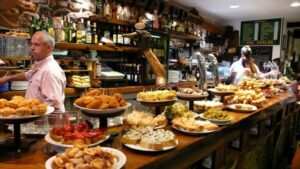Move over Nicosia. In 1881, Seville recorded a temperature of 51C, earning it the name of The Frying Pan of Europe! Granted, this was a one-off, but Seville’s location – hemmed in by mountains in the arid south of Spain – can, on occasion, cause temperatures to soar well above the norm.
It’s not just the weather that’s scorching: Seville is also the birthplace of the fiery flamenco. Believed to have come to Spain with the Roma who migrated from India in the 15th century, this passionate tradition is enjoyed all over a city that’s renowned for its arts, and its cuisine…
Of course you’ll know of the bitter Seville oranges: the trees line the city streets, and the orange itself is exported by the tonne to the UK where it’s made into marmalade. But Seville also claims to be the birthplace of tapas: legend says locals enjoyed strolling from bar to bar, snacking en route. The plates on which these nibbles appeared were often used as covers (or ‘tapas’ in Spanish) for their drinks!

But it’s not all tapas. Seville is also famed for its sandwiches. The serranito is the city’s signature sandwich. Seared pork loin and salty serrano ham topped with tomato and grilled green pepper, this crusty baguette is a favourite. And the montadito de pringá (a sandwich of chicken, blood sausage, and chorizo) is also worth a try.
On the dessert side, there’s the Spanish answer to French toast: torrijas. Traditionally served at Easter, this consists of deep-fried stale bread soaked in beaten eggs and smothered in sugar syrup, honey, sweetened milk or ice cream. Or the local roscos fritos: fried donuts coated in sugar; another popular Holy Week sweet.
And while the oranges for which the city is famed don’t pop up in the cuisine as often as one might expect, they do make an appearance in a well-known drink: vino de naranja is always made with the bitter peel of Seville oranges.







Click here to change your cookie preferences